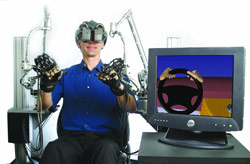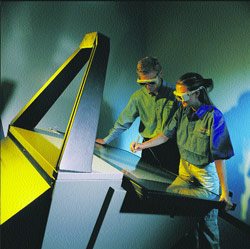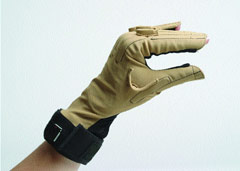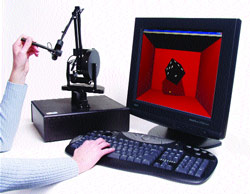Resource Guide: Get Touchy-Feely with Haptics
Forget your mouse, alternate input devices give new meaning to data "manipulation."
Latest News
December 1, 2004
By Glenn Hartwig
The latest devices for entering data and taking measurements are notonly imaginative and unique, but also make previously painstaking—ifnot impossible—operations easy to accomplish. Forget tapping on akeyboard or clicking with your mouse, the variety of new data inputdevices, and the extra dimension of tactile feedback you get, makesthese things interesting, useful, and possibly a lot of fun.

Above: Immersion’s CyberForce Haptic Workstation appliesground-referenced forces to each of the fingers and hands, and userscan sit or stand. The software loads CATIA V5, and a CAVE environmentcan be substituted for the head-mounted display.
A New Twist
To see how you might benefit from some of the newer technologies, itfirst helps to equip yourself with a sense of adventure and a pair offresh eyes. Take the ShapeTape from Measurand, Inc. of Fredericton, NewBrunswick. It’s a flexible, sensor-bearing strip that originally foundfavor with film and video animators because it can input freeformcurves during simple twisting and bending motions. The concept wasexpanded to a full-body system called the ShapeWrap.
According to Measurand Vice President Scott Thomson, a partialapplication of the ShapeWrap system, the Shape-S, might work forergonomic studies. “With the arms and the back tapes we can measureforces on the back using leverage calculations based on the weightyou’re carrying and the distance it is from your back,” says Thomson.He says the device could be useful, for example, in studying howchanging the height or width of an assembly line might reduce workerstrain and fatigue.
A product still under development, called the ShapeHand, uses sensorstrips small enough to fit along the fingers and joints of a person’shand. According to Thomson, “The interest seems to be in animating thehand and doing MRI research.” He notes that you can feed the outputinto brainscan devices to show which parts of the brain are activatedduring specific kinds of hand and finger motions.
While Phantom hardware is coupled with FreeForm design software formodeling and even CAD/CAM applications, Steingart says the company isalso marketing a software development kit called Ghost, with whichusers can build their own applications to make use of force feedbackand 3D navigation technologies.

Lowering costs is also a way of democratizing new technologies and,while a lot of haptic devices today can come with horse-chokingpricetags, more affordable, entry-level technology may be just aroundthe corner. “We are working on that. There’s more to come,” saysSteingart.
What Happens If I Push This Button?
Of course, alternate input can come in more familiar guises, such as the SpaceBallfrom 3Dconnexion (Los Gatos, CA).
“Mapping CAD functions onto buttons on our devices is one area thatwe’re starting to look at more seriously” to provide enhanced inputcapabilities, says Niraj Swarup, 3Dconnexion’s vice-president ofmarketing. “We’re trying to make it even simpler because, as you’reworking, there’s a need for people to feed some commands to the systemand the only way to do it now is to click on something with the mouse.”
Swarup says that a more efficient way of selecting menu choices is to"program some of the buttons on our devices to do it. Frequentfunctions that you do day in and day out, if you’re able to programthose on a few of the buttons, you can just work that much faster.”
SensAble’s Phantom Premium 1.5 approximates thelower arm’s range of motion. Its passive stylus and thimble gimbalprovides three degrees of freedom positional sensing and three degreesof freedom force feedback.
The Fakespace ImmersaDesk M1 is a portable virtual modeling stationwith an adjustable 44-in. screen. Optional head tracking maintainscorrect perspective of stereo images as users move around the desk.
While this is similar to the function keys on a keyboard, Swarup notesthat “the difference is that you’ve already got one hand on a devicethat you’re using for rotating, panning, and zooming objects. If thebuttons are right there next to the hand, you don’t have to physicallylift it to move it onto the keyboard.”
When Push Comes To Shove
There’s more to tactile tools, like the Phantom haptic devices beingdeveloped by SensAble Technologies of Woburn, Massachusetts. Accordingto Bob Steingart, vice president of marketing at SensAble, “There’s adevice that sits on your desk and it has an arm and linkages and youcan move it around with six degrees of freedom. You can move it withina space of roughly a cubic foot in any direction. It captures thosemotions and then with that, you can not only do 3D navigation, but wealso do touch feedback at a rate of 1000 times per second. We can takean image on the screen, such as a face, and actually feel the featuresin tremendous detail.”

Glove Is In The Air
Greg Belaus, senior director of the industrial group at ImmersionCorporation of San Jose, California, says that the company’sinteraction products are glove-based 3D-environment products that startwith the CyberGlove at the lower end of the product line.
“These are articulated gloves with bend sensors in them,” he says.“Literally, with our products, you can reach into 3D models and feelthem, press up against a virtual surface, get force feedback, actuallyfeel that virtual environment.”
Immersion’s CyberGlove has up to 22 flexion sensors to transform handand finger motions into real-time joint-angle data for prototypeevaluation, virtual reality biomechanics, and animation.
According to Belaus, a lot of interest in Immersion’s high-endproducts, like the Haptic Workstation, is for use in maintenanceapplications. “Imagine an aircraft engine,” he says. “The optimaldesign for that engine might create problems in maintenance.” By seeingand feeling potential problems—like access to fasteners—beforemanufacturing, he notes that “haptics not only allows you to eliminatephysical prototypes, but also allows you to iterate on the design manymore times.”

While the Haptic Workstation is expensive and intended for specializedapplications, Belaus says, “on the horizon, we have other products andtechnologies to bring haptics to more mainstream design.” He adds the3D scanning field is next in line for technological improvement. “Ithink low-cost, optical solutions that are easy to use and don’trequire a lot of manual cleanup are on the way.”
Self Examination
Every now and then it’s a good idea to take stock and see whether theremay be an elusive something that can give you an extra advantage. Ifyou take a step back and consider some of what’s going on, you might besurprised to find that a new solution to old, aggravating problems isalready waiting in the wings.
Glenn Hartwig is a technical writer who lives in southwestern NewHampshire. You can send him e-mail about this article c/[email protected].
Company Information
FARO Technologies / LaunchPad Office / Immersion Corp.
ITAC Systems / JetWay Technologies / Phidgets, Inc.
SensAble Technologies / Wacom Technology Corp.
Subscribe to our FREE magazine, FREE email newsletters or both!
Latest News
About the Author
DE’s editors contribute news and new product announcements to Digital Engineering.
Press releases may be sent to them via [email protected].






